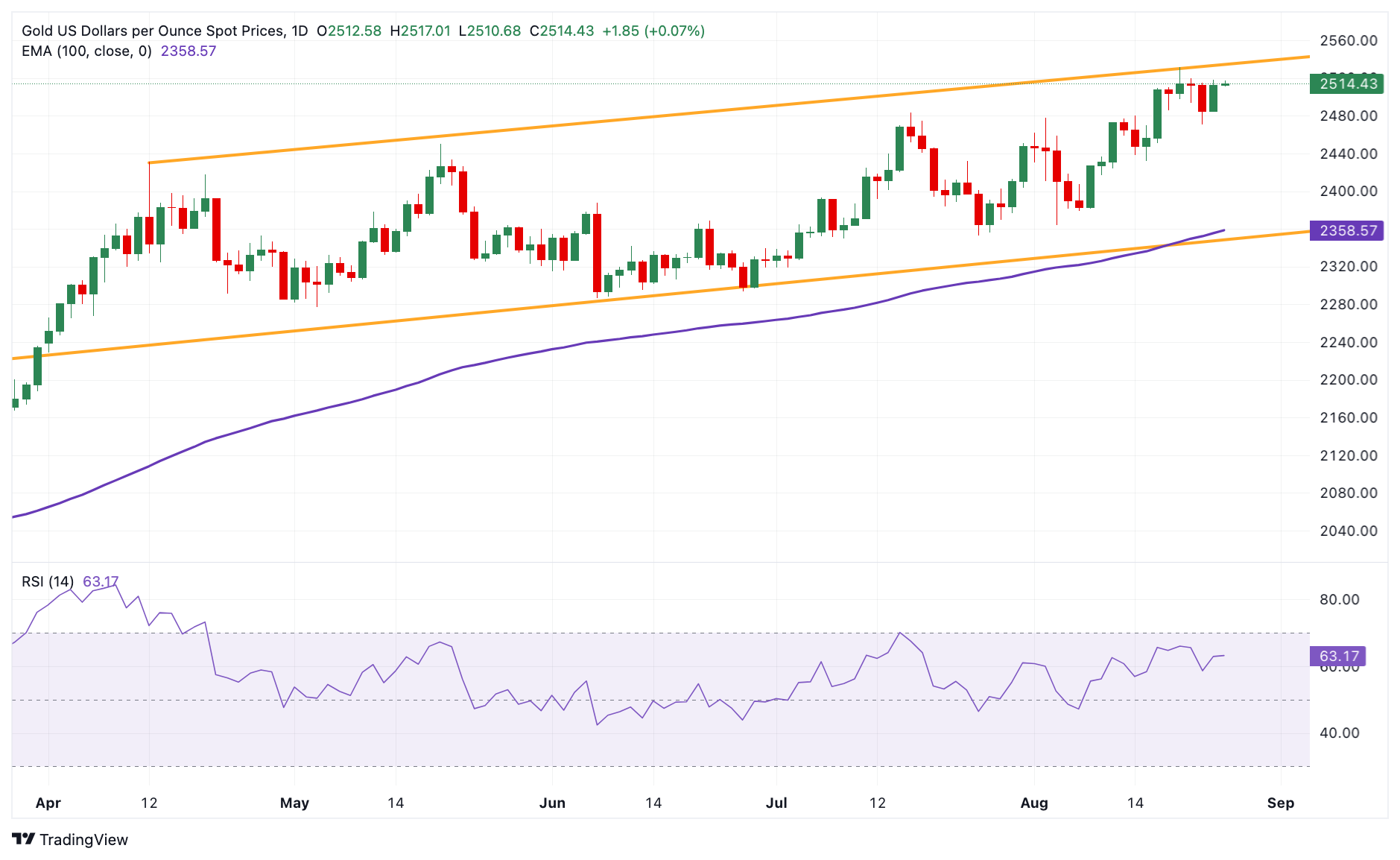- Gold prices gain traction in Monday’s Asian session.
- Expectations of a Fed rate cut and ongoing geopolitical tensions continue to support the price of Gold.
- U.S. durable goods orders for July are due out later on Monday.
Gold (XAU/USD) price remains in positive territory above the psychological support of $2,500 on Monday. The precious metal’s rally is fueled by rising expectations that the US Federal Reserve (Fed) will start cutting borrowing costs in September. The expectation of lower interest rates is generally positive for Gold as it reduces the opportunity cost of holding the non-interest-paying asset.
Moreover, escalating geopolitical tensions in the Middle East and economic uncertainty are likely to boost safe-haven demand, benefiting the gold price. On the other hand, weak demand in the Chinese economy could undermine the yellow metal as China is the largest producer and consumer of gold globally. Later on Monday, the US Durable Goods Orders for July will be released. The highlights of this week will be the preliminary US Annualized Gross Domestic Product (GDP) for the second quarter and the Personal Consumption Expenditure (PCE) Price Index for July, which will be released on Thursday and Friday, respectively.
Daily Market Wrap: Gold price remains strong amid firmer Fed rate cut expectations
- Fed Chairman Powell said Friday at the Kansas City Fed’s annual economic symposium in Jackson Hole, “The time has come to tighten policy.”
- The July FOMC minutes released last week indicated that a “large majority” of Fed officials believe a September rate cut will be appropriate as long as there are no surprises in the data.
- Philadelphia Fed President Patrick Harker said he supports two or three interest rate cuts in 2024 unless there are substantial changes in U.S. economic data.
- Chicago Fed President Austan Goolsbee said monetary policy is currently at its most restrictive level, and the Fed’s focus is now shifting toward fulfilling its employment mandate.
- Hezbollah launched hundreds of rockets and drones at Israel early Sunday, while the Israeli military said it carried out a wave of preemptive strikes in southern Lebanon to thwart a large-scale rocket and drone attack by Hezbollah, according to Reuters.
Technical Analysis: Gold price continues its long-term bullish momentum
Gold price is trading in positive territory on the day. The precious metal has been trading within a five-month-old uptrend channel. However, the overall bullish environment for the yellow metal remains intact as it remains above the 100-day exponential moving average (EMA) on the daily chart. Moreover, the 14-day Relative Strength Index (RSI) is in the bullish zone near 62.70, suggesting that the trend still favors the bulls.
If Gold prints a couple more bullish candles, we could see a rally towards the $2,530-$2,535 region, the all-time high and the upper boundary of the trend channel. A decisive break above this level could attract more buyers who could sustain a rally towards the psychological barrier of $2,600.
On the other hand, the initial support level emerges at $2,470, the low of August 22. If the XAU/USD pair sees more bearish candles below the mentioned level, then the yellow metal might attract enough sellers to drag it down to $2,432, the low of August 15. The crucial level of contention is seen at the $2,350-$2,360 zone, the lower boundary of the trend channel and the 100-day EMA.

Gold FAQs
Gold has played a pivotal role in human history as it has been widely used as a store of value and a medium of exchange. Today, apart from its luster and use for jewelry, the precious metal is considered a safe haven asset, meaning it is considered a good investment in turbulent times. Gold is also considered a hedge against inflation and currency depreciation as it is not dependent on any particular issuer or government.
Central banks are the largest holders of gold. In order to support their currencies in turbulent times, central banks tend to diversify their reserves and buy gold to improve the perception of the strength of the economy and the currency. High gold reserves can be a source of confidence in a country’s solvency. Central banks added 1,136 tonnes of gold worth about $70 billion to their reserves in 2022, according to data from the World Gold Council. This is the largest annual purchase on record. Central banks in emerging economies such as China, India and Turkey are rapidly increasing their gold reserves.
Gold has an inverse correlation with the US Dollar and US Treasury bonds, which are the main reserve and safe haven assets. When the Dollar depreciates, the price of Gold tends to rise, allowing investors and central banks to diversify their assets in turbulent times. Gold is also inversely correlated with risk assets. A rally in the stock market tends to weaken the price of Gold, while sell-offs in riskier markets tend to favor the precious metal.
Gold prices can move due to a wide range of factors. Geopolitical instability or fears of a deep recession can cause the price of Gold to rise rapidly due to its status as a safe haven asset. As a non-yielding asset, Gold prices tend to rise when interest rates fall, while rising money prices often weigh down the yellow metal. Still, most of the moves depend on how the US Dollar (USD) performs, as the asset is priced in dollars (XAU/USD). A strong Dollar tends to keep Gold prices in check, while a weaker Dollar is likely to push Gold prices higher.
Source: Fx Street
I am Joshua Winder, a senior-level journalist and editor at World Stock Market. I specialize in covering news related to the stock market and economic trends. With more than 8 years of experience in this field, I have become an expert in financial reporting.







